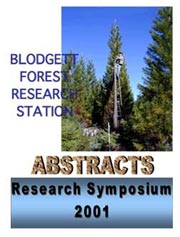Biogenic hydrocarbons contribute significantly to production of tropospheric ozone in both rural and urban areas. Complete mechanisms of the reactions of dominant biogenic hydrocarbons and the mixing ratios of reaction products in the atmosphere is therefore of interest and will be useful in production of accurate photochemical models that predict tropospheric ozone formation. Two important biogenic hydrocarbons in western North America are isoprene and 2-methyl-3-buten-2-ol (MBO). Primary products from the reaction of isoprene with OH radical include methyl vinyl ketone, methacrolein, formaldehyde, and 3-methylfuran. Methyl vinyl ketone and methacrolein also react with OH-, producing hydroxyacetone, glycolaldehyde, methylglyoxal, and other hydroxycarbonyls. MBO reacts with OH- to produce acetone, formaldehyde, glycolaldehyde, and 2-hydroxy-2-methylpropanal. The hydroxycarbonyl and dicarbonyl products have been difficult to analyze in the atmosphere due to their high polarity and the expected low mixing ratios. Herein we report collection of hydroxycarbonyl and dicarbonyl compounds in a Cofer Scrubber using and O-(2,3,4,5,6-pentafluorobenzyl)-hydroxylamine (PFBHA) derivatization of carbonyl groups followed by bis(trimethylsilyl)trifluoroacetamide (BSTFA) derivatization of -OH groups. Identification and quantification is accomplished by using gas chromatography with ion trap mass spectrometry. We report diurnal trends in mixing ratios of glycolaldehyde, hydroxyacetone, 2-hydroxy-2-methylpropanal, and methylglyoxal at the Blodgett Forest for three days during the summer of 2000.
|
Contact Author: Reggie S. Spaulding, Department of Environmental Toxicology, University of California, Davis, One Shields Avenue, Davis, CA 95616, (530) 752-2541, e-mail: szreggie@mailbox.ucdavis.edu
|

